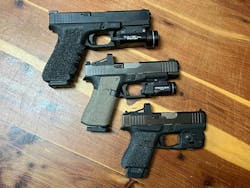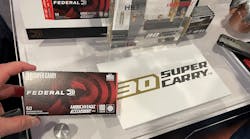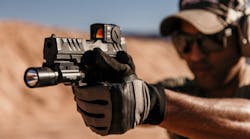Just recently, as happens all too often these days, a debate came up on an editor’s social media feed wherein several “experts” were discussing the need for lights mounted on weapons. That particular discussion was about lights on handguns, but the same discussion is held—admittedly less often—about lights mounted on long guns and subguns as well. The pro-light vs no-light discussion often starts to sound like a .45ACP vs (pick anything) discussion: either side is fixed in their opinion and seems to have an “all or nothing” approach. Being a bit more realistic, there are some circumstances where a mounted light can be very beneficial and there are some job assignments that simply require more hands than a human has, so a mounted light can be beneficial. The largest challenges get voiced when non-law enforcement personnel mount lights on their handguns (and whose business is that anyway?) or an entire agency authorizes/places lights on every officer’s handgun.
This article appeared in the March/April issue of OFFICER Magazine. Click Here to subscribe to OFFICER Magazine.
Before we deep dive into the concept of lights on handguns, let’s discuss the necessity of light in general. Humans make decisions based on input received through the five senses. That said, 80% of the data used to make decisions comes in visually, and we require light to see. With at least two-thirds of each day (on average) being hours of low or no light, and with a lot of work circumstances being in places with low or no light, having a flashlight is mandatory for any officer. And, as any veteran officer will tell you, having a backup is equally mandatory. Two is one; one is none. Better to have it and not need it than to need it and not have it. So, we can take it without argument that every officer should have a primary flashlight and a backup. It can be argued that they should be equal in performance and given the small form factor of today’s flashlights, having two identical lights is no big deal. Put one on the vest and one on the duty belt, and you’re good to go. Yes, have both of them on your person. Having a spare flashlight in your patrol vehicle when the one in your hand dies in the dark does you no good.
Having determined the necessity of a good quality flashlight, is there any value to having it mounted on your handgun? Some long-time experts in the field of defensive handgunning say that there is no need for a light on a handgun and that the potential for negative performance increases with the attachment of such. Too many stories get told about officers using the mounted light for non-use-of-force situations, such as changing a flat tire or illuminating a patient for EMS personnel. Further, those who have done enough lowlight training have seen situations where the “bad guy” shoots at what he can see in the dark, which happens to be the officer’s weapon light… on the handgun… held mostly in front of the officer’s face. Not a good place to have incoming rounds aimed.
Others, more recently trained, maintain that having a light on a handgun is necessary because of the circumstances wherein an officer is addressing a potentially lethal threat in low-light situations and needs the support hand free to manipulate doors or other obstacles. Sometimes the argument thrown back is, “We didn’t need it forever before lights were small enough to fit on guns, so why do we need them now?”
Well, let’s agree that progress is a good thing. Technology develops and options are good. Having the option of a light on a handgun isn’t a bad thing. Having the light mounted and carried without proper training, with no policy in place to control use, and confusing the officer’s response to threats under fire is a bad thing.
If your agency is going to authorize weapon-mounted lights on handguns (or long guns for that matter), or issue and mandate the carry of such, then proper policy has to be developed; proper holsters have to be selected; proper training has to be developed with appropriate standards, and that training has to be delivered BEFORE officers mount those lights on their handguns. The policy must address improper use and disciplinary actions for such. The training must be in-depth and occur at least as often as your weapons qualifications are performed. The use of the light must be critiqued equally with the use of force, and passing qualifications with the weapon-mounted light as well documented as the firearms qualifications.
Just the development and creation of the policy and training often slows an agency down from widespread implementation of a weapons-mounted light policy. The policy must address lights on off-duty weapons as well to include holster design features and use of the light, just like the on-duty policy. The policy, just like the firearms policy, must address exceptions or differences for plainclothes officers and “modified uniform” assignments. With all the administrative, training and equipment concerns managed (including battery management for the lights), then a widespread implementation is practical and defensible. Then the easy part starts: selecting the light your agency will purchase and scheduling the training for merging in the handgun systems. Yes, systems. Once you start mounting lights (or optics) on a handgun, it’s no longer just a handgun; it’s a weapon system. The system must be trained and maintained.
It’s safe to predict that duty handguns across the country will be equipped with weapon-mounted lights, universally within (probably) the next ten years, if not sooner. The entire industry that supports firearms, such as the light manufacturers and holster designers/manufacturers are all either prepared or preparing for it. Agencies that are avoiding it, or permitting it without proper administrative and training controls, need to start facing that reality.
This article appeared in the March/April issue of OFFICER Magazine.



